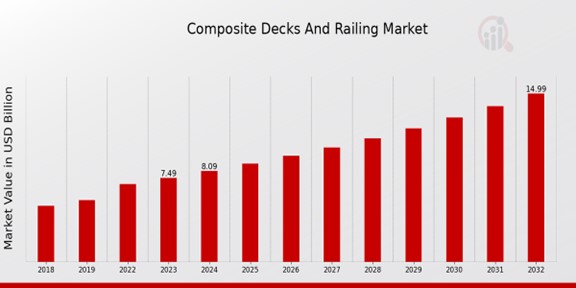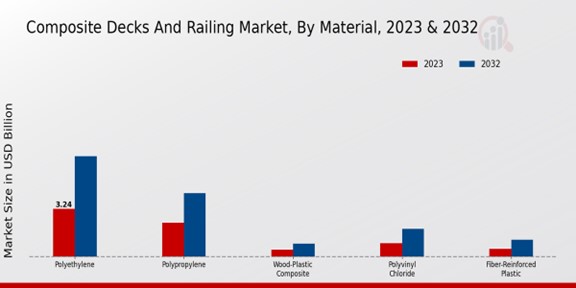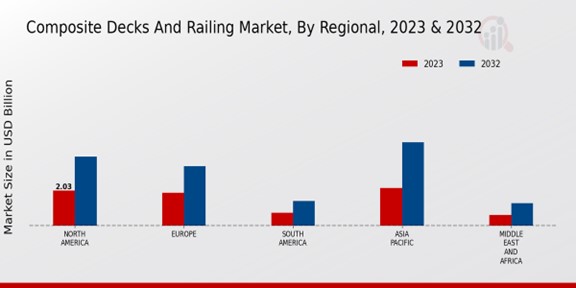Global Composite Decks and Railing Market Overview
The Composite Decks and Railing Market Size was estimated at 8.74 (USD Billion) in 2024. The Composite Decks and Railing Market is expected to grow from 9.44 (USD Billion) in 2025 to 18.90 (USD Billion) by 2034. The Composite Decks and Railing Market CAGR (growth rate) is expected to be around 8.0% during the forecast period (2025 - 2034)
Key Composite Decks and Railing Market Trends Highlighted
The increasing demand for low-maintenance, weather-resistant decking and railing materials is driving the growth of the composite decking and railing market. Homeowners and businesses are seeking alternatives to traditional wood products that require constant upkeep and can succumb to rot and decay.
Composite materials, made from a blend of wood fibers and polymers, offer superior durability and aesthetics, making them an attractive option for outdoor living spaces.
Another key driver is the growing popularity of outdoor entertainment areas. As homeowners spend more time enjoying their outdoor spaces, they are investing in high-quality decking and railing systems that enhance both the functionality and appearance of their properties.
The demand for composite decking and railing is also being fueled by the increasing awareness of environmental sustainability. Composite materials are made from recycled materials, reducing the use of natural resources and minimizing the environmental impact of construction projects.
Recent trends in the composite decking and railing market include the emergence of innovative design features and the increasing use of technology. Manufacturers are introducing products with unique patterns, colors, and textures to cater to the diverse tastes of consumers.
Additionally, the integration of smart features, such as lighting and heating systems, is enhancing the functionality and comfort of outdoor living spaces.

Source: Primary Research, Secondary Research, MRFR Database and Analyst Review
Composite Decks and Railing Market Drivers
Rising Demand for Low-Maintenance Decking and Railing Solutions
The increasing popularity of composite decking and railing systems can be, above all, explained by the fact that they are low maintenance. Unlike traditional decks and railings made from wood, which require regular staining, sealing or painting, composites demonstrate high resistance to rot, decay, and insects.
As a result, there is no need for an owner to spend much time on maintenance. To put it simply, modern Composite Decks and Railings are the perfect choice for many families with kids who live a hectic life and want to avoid unnecessary troubles and homeowners who admire the idea of having a low-maintenance outdoor living space but do not have enough time for its maintenance.
Thus, the increasing popularity of such products results in a growing demand for the Composite Decks and Railing Market, which is expected to drive its expansion in the future.
Growing Popularity of Outdoor Living Spaces
The growth of outdoor living is the major factor that has increased the demand for composite decking and railing systems. People are increasingly recognizing the benefits of enjoying the comfort and beauty of the outdoor environment.
Composite Decks and Railings provide the best solution in such an environment as they offer a surface that is durable and easy to maintain thus complementing any outdoor decor.
The composite materials used in their manufacture can be used in the creation of unique designs and layouts enhancing the versatile properties to meet the specific homeowner needs.
Such factors are expected to be the driving force behind the growth of the Composite Decks and Railing Market.
Increasing Adoption in Commercial and Public Spaces
Composite decking and railing systems are gaining traction in commercial and public spaces due to their durability, safety, and aesthetic appeal.
These materials are ideal for high-traffic areas, such as parks, resorts, and outdoor dining spaces, where they can withstand heavy foot traffic and harsh weather conditions.
Composite Decks and Railings also offer excellent slip resistance, making them a safer option for public areas.
Additionally, their low-maintenance properties make them a cost-effective solution for commercial and public space managers, reducing the need for ongoing repairs and replacements.
The increasing adoption of composite decking and railing systems in commercial and public spaces is expected to contribute to the growth of the Composite Decks and Railing Market.
Composite Decks and Railing Market Segment Insights
Composite Decks and Railing Market Material Insights
In the forthcoming years, Material is anticipated to outgrow other segments in the Composite Decks and Railings market. Currently, polymer polyethylene is the leading material of Composite Decks and Railings with over 50% market share.
This is expected to grow due to polyethylene's physical properties of ultralightweight, durability, and resistance to any weather conditions.
Moreover, another polymer, polypropylene, has a 25% market share currently. It is in every sense like polyethylene, but polypropylene is slightly more rigid with a higher melting point.
Wood-plastic composite is produced using wood fibers and plastic resins, gaining popularity as being a strong and durable material.
Therefore, it obtained a 15% market share and is anticipated to grow over 6% within the next five years. Polyvinyl chloride is another plastic used in producing Composite Decks and Railings with a 5% market share.
This polymer is a strong and durable material, but it is not as weather-resistant as polyethylene or polypropylene. Fiber-reinforced plastic is a composite material part of the polymer family of plastics, but it is reinforced by carbon fibers or glass fibers.
This material is very strong and ultralight, but it is more expensive compared to other composite materials. It obtains 5% of the market share and is expected to grow by over 7% within the next five years. Manufacturers use various materials depending on budget and the look desired outside the home.
For example, polyethylene is a great choice for consumers who are budget-conscious and can provide resistance to any weather conditions. On the other hand, polypropylene is an alternative for consumers who would like a slightly more rigid polymer with a higher melting point.
Meanwhile, wood-plastic composite is appropriate for those customers that want the product to be strong. Polyvinyl chloride is suitable for people that want strong and durable material, but it is not as weather-resistant as polyethylene or polypropylene.
Finally, fiber-reinforced plastic is relevant for people that want to be strong, ultralight, and last for a long time with the selection of carbon fibers or glass fibers.

Source: Primary Research, Secondary Research, MRFR Database and Analyst Review
Composite Decks and Railing Market Application Insights
On the premise of application, the Composite Decks and Railing Market is segmented into Decks, Railings, Fencing, Privacy Screens, and Pool Surrounds. Of these applications, the Decks and Railings application sections will collectively generate over 70% of the market income in 2024.
The growth of the Decks application section is attributed to the high demand for open spaces. The Railings application section, on the other hand, is likely to grow on account of the rising utilization of composite materials in the commercial and residential building structure.
Using Fencing and Privacy Screens as alternatives for wood and metal material, on the other hand, is another significant mover in this market.
The application section Pool Surrounds is anticipated to rise at a steady growth rate over the next few years as the utilization of composite decking by homeowners around swimming pools increases.
Thus, the Composite Decks and Railing Market will continue to grow rapidly, driven by the increasing demand for sustainable building materials that are user-friendly.
Composite Decks and Railing Market End User Insights
The Composite Decks and Railing Market is segmented by End User into Residential, Commercial (Hospitality, Healthcare, Education, Recreation), and Industrial.
The Residential segment is expected to dominate the market, accounting for over 60% of the Composite Decks and Railing Market revenue in 2024.
The growing demand for Composite Decks and Railings in residential applications is attributed to their durability, low maintenance, and aesthetic appeal.
The Commercial segment is also expected to witness significant growth, driven by the increasing use of Composite Decks and Railings in hotels, restaurants, hospitals, and schools.
The Industrial segment is expected to have a moderate growth rate, driven by the demand for Composite Decks and Railings in industrial facilities such as warehouses and factories.
Composite Decks and Railing Market Price Range Insights
The Composite Decks and Railing Market segmentation by price range includes economy, mid-range, and high-end segments.
The mid-range segment is expected to hold the largest share of the market in 2024, owing to its affordability and wide range of options.
The high-end segment is expected to grow at the fastest rate during the forecast period due to the increasing demand for premium products. The economy segment is expected to account for a significant share of the market, as it caters to the needs of budget-conscious consumers.
Composite Decks and Railing Market Distribution Channel Insights
The distribution channel segment plays a crucial role in the Composite Decks and Railing Market, influencing market growth and revenue generation. Key distribution channels include online retailers, home improvement stores, contractors, and landscapers.
Online retailers have gained significant traction in recent years due to their convenience, wide product selection, and competitive pricing. They account for a substantial share of the Composite Decks and Railing Market revenue and are projected to maintain their dominance in the coming years.
Home improvement stores offer a more hands-on shopping experience and provide professional advice to customers. Contractors and landscapers specialize in the installation and maintenance of Composite Decks and Railings, catering to specific customer needs and ensuring high-quality workmanship.
The segmentation of the distribution channel provides insights into the diverse preferences and purchasing patterns of customers, enabling manufacturers and suppliers to tailor their strategies accordingly.
Composite Decks and Railing Market Regional Insights
The Composite Decks and Railing Market is segmented into North America, Europe, APAC, South America, and MEA.
The North American region is expected to dominate the market due to the increasing demand for Composite Decks and Railings in residential and commercial construction.
The European market is also expected to grow significantly due to the increasing awareness of the benefits of composite materials.
The APAC market is expected to witness the highest growth rate due to rapid urbanization and the growing construction industry in the region.
The South American and MEA markets are also expected to grow at a steady pace due to the increasing demand for composite materials in these regions.

Source: Primary Research, Secondary Research, MRFR Database and Analyst Review
Composite Decks and Railing Market Key Players and Competitive Insights
Major players in the Composite Decks and Railing Market are constantly striving to gain a competitive edge by developing innovative products and expanding their reach.
Leading Composite Decks and Railing Market players are investing heavily in research and development to introduce new and improved products that meet the evolving needs of customers.
The Composite Decks and Railing Market development is also driven by the growing demand for eco-friendly and sustainable building materials, which is leading to the adoption of composite decking and railing systems.
The Composite Decks and Railing Market Competitive Landscape is expected to remain highly competitive in the coming years, with key players focusing on product innovation, strategic partnerships, and geographical expansion to gain market share.
Fiberon, a leading player in the Composite Decks and Railing Market, has a strong brand reputation and a wide product portfolio catering to both residential and commercial applications. The company has a presence with manufacturing facilities in the United States, Canada, and Europe.
Fiberon is known for its high-quality products, innovative designs, and commitment to sustainability. The company's focus on customer satisfaction and its extensive distribution network have contributed to its success in the Composite Decks and Railing Market.
Trex Company, a prominent competitor in the Composite Decks and Railing Market, is known for its innovative composite decking and railing systems. The company has a strong focus on research and development, and it continuously introduces new products to meet the changing demands of the market.
Trex Company has a wide distribution network and a presence, making its products accessible to customers worldwide. The company's commitment to sustainability and its environmentally friendly products have also contributed to its success in the Composite Decks and Railing Market.
Key Companies in the Composite Decks and Railing Market Include
- GAF
- LP Building Products
- AZEK Building Products
- DuraLife Decking
- Tamko Building Products
- IKO
- Westlake Chemical
- Trex Company
- Fiber Composites
- Royal Building Products
- Fiberon
- MoistureShield
- Wolf Home Products
- Versatex
- CertainTeed
Composite Decks and Railing Market Developments
The growth of the market is attributed to the rising popularity of composite decking and railing systems due to their durability, low maintenance requirements, and aesthetic appeal.
Recent news developments in the market include the launch of new products by major manufacturers, such as Trex's new Transcend line of decking and railing products, which feature a realistic wood-grain finish and are made from 95% recycled materials. Other key players in the market include Fiberon, Azek Building Products, and TimberTech.
The market is expected to witness significant growth in the Asia-Pacific region, driven by the increasing demand for composite decking and railing systems in countries such as China, India, and Australia.
The growing construction industry in these countries is also expected to contribute to the growth of the market.
Composite Decks and Railing Market Segmentation Insights
Composite Decks and Railing Market Material Outlook
- Polyethylene (PE)
- Polypropylene (PP)
- Wood-Plastic Composite (WPC)
- Polyvinyl Chloride (PVC)
- Fiber-Reinforced Plastic (FRP)
Composite Decks and Railing Market Application Outlook
- Decks
- Railings
- Fencing
- Privacy Screens
- Pool Surrounds
Composite Decks and Railing Market End User Outlook
- Residential
- Commercial (Hospitality, Healthcare, Education, Recreation)
- Industrial
Composite Decks and Railing Market Price Range Outlook
- Economy
- Mid-Range
- High-End
Composite Decks and Railing Market Distribution Channel Outlook
- Online Retailers
- Home Improvement Stores
- Contractors
- Landscapers
Composite Decks and Railing Market Regional Outlook
- North America
- Europe
- South America
- Asia-Pacific
- Middle East and Africa
| Report Attribute/Metric |
Details |
| Market Size 2024 |
8.74 (USD Billion) |
| Market Size 2025 |
9.44 (USD Billion) |
| Market Size 2034 |
18.90 (USD Billion) |
| Compound Annual Growth Rate (CAGR) |
8.0% (2025 - 2034) |
| Report Coverage |
Revenue Forecast, Competitive Landscape, Growth Factors, and Trends |
| Base Year |
2024 |
| Market Forecast Period |
2025 - 2034 |
| Historical Data |
2020 - 2024 |
| Market Forecast Units |
USD Billion |
| Key Companies Profiled |
GAF, LP Building Products, AZEK Building Products, DuraLife Decking, Tamko Building Products, IKO, Westlake Chemical, Trex Company, Fiber Composites, Royal Building Products, Fiberon, MoistureShield, Wolf Home Products, Versatex, CertainTeed |
| Segments Covered |
Material, Application, End User, Price Range, Distribution Channel, Regional |
| Key Market Opportunities |
Growing demand for sustainable and durable materials Expansion into emerging markets Advancements in composite technology Increasing use in commercial and public spaces Government incentives for sustainable building practices |
| Key Market Dynamics |
Rising demand for sustainable materials Growing popularity of outdoor living spaces Technological advancements in composite materials Increasing construction activities Government regulations promoting the use of sustainable materials |
| Countries Covered |
North America, Europe, APAC, South America, MEA |
Frequently Asked Questions (FAQ) :
The Composite Decks and Railing Market is anticipated to reach a valuation of approximately USD 9.44 billion in 2025.
The Compound Annual Growth Rate (CAGR) of the Composite Decks and Railing Market is estimated to be around 8.0% during the forecast period from 2025 to 2034.
Factors such as increasing demand for outdoor living spaces, rising popularity of composite materials due to their durability and low maintenance, and growing construction activities in residential and commercial sectors are propelling the growth of the Composite Decks and Railing Market.
North America is anticipated to dominate the Composite Decks and Railing Market throughout the forecast period, owing to the presence of a large number of manufacturers and high demand for composite decking and railing products in the region.
Some of the notable players in the Composite Decks and Railing Market include Fiberon, LLC, Trex Company, Inc., AZEK Building Products, CertainTeed Corporation, and Wolf Home Products.
Composite Decks and Railings find extensive applications in residential properties, such as houses and apartments, as well as in commercial settings, including hotels, resorts, and restaurants.
Composite Decks and Railings offer superior durability compared to traditional materials like wood. They are resistant to rotting, moisture damage, and insect infestation, providing a longer lifespan with minimal maintenance.
Composite Decks and Railings provide several advantages over traditional materials. They are more durable, require less maintenance, and are available in a wider range of colors and styles, allowing for greater design flexibility.
Key trends influencing the Composite Decks and Railing Market include the growing adoption of sustainable building practices, increasing focus on outdoor living spaces, and advancements in composite material technology.
The Composite Decks and Railing Market is projected to reach a valuation of approximately USD 18.90 billion by 2034, exhibiting a significant growth trajectory over the forecast period.

















